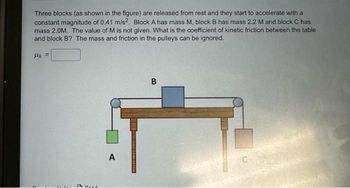
College Physics
11th Edition
ISBN: 9781305952300
Author: Raymond A. Serway, Chris Vuille
Publisher: Cengage Learning
expand_more
expand_more
format_list_bulleted
Question
thumb_up100%

Transcribed Image Text:Three blocks (as shown in the figure) are released from rest and they start to accelerate with a
constant magnitude of 0.41 m/s2. Block A has mass M, block B has mass 2.2 M and block C has
mass 2.0M. The value of M is not given. What is the coefficient of kinetic friction between the table
and block B? The mass and friction in the pulleys can be ignored.
k=
Pneed
A
B
C
Expert Solution
This question has been solved!
Explore an expertly crafted, step-by-step solution for a thorough understanding of key concepts.
This is a popular solution
Trending nowThis is a popular solution!
Step by stepSolved in 2 steps with 2 images

Knowledge Booster
Similar questions
- Please show steps, thanksarrow_forwardA Box is placed on a 40° slope with a coefficient of friction of 0.30. The box starts approximately at 6.0m off the ground. It slides onto a horizontal part with a coefficient of 0.45. How far does it slide along this part?arrow_forwardThe figure shows the configuration of two identical bricks. In case 1 the bricks are placed end to end. In case 2 the bricks are stack on top of each other. What can you say about the kinetic friction when the bricks are pushed across a tabletop with constant speed?arrow_forward
- We start with some review problems A crate of mass 20.0 kg rests on a level surface, with a coefficient of kinetic friction 0.219. You push on the crate with an applied force of 297 N. What is the magnitude of the crate s acceleration as it slides? 12.70 m/s^2 14.85 m/s^2 6.35 m/s^2 20.79 m/s^2arrow_forwardA hockey puck slides with an initial speed of 56.7 m/s on a large frozen lake. The coefficient of kinetic friction between the puck and the ice is 0.05. What is the acceleration on the hockey puck caused by friction? Assume the puck's velocity is in the positive-x direction. And what is the speed of the puck after 6 s?arrow_forwardBlocks 1 and 2 are moving to the right on a frictionless surface by the tension TB = 36 N as shown. m1 = 2.0 kg, and m2 = 3.2 kg. What is the magnitude of the acceleration of block 2, in m/s²? Your answer needs to have 2 significant figures, including the negative sign in your answer if needed. Do not include the positive sign if the answer is positive. No unit is needed in your answer, it is already given in the question statement. m₁ TA m₂ TBarrow_forward
- A block slides down a 18° incline. The coefficient of kinetic friction between the block and theincline is 0.22. What is the magnitude of the block's acceleration?arrow_forwardWe start with some review problems A crate of mass 42.0 kg rests on a level surface, with a coefficient of kinetic friction 0.257. You push on the crate with an applied force of 375 N. What is the magnitude of the crate s acceleration as it slides? 14.29 m/s^2 6.41 m/s^2 8.93 m/s^2 2.56 m/s^2arrow_forwardB In the figure, block A has a mass of 9.06 kg. It rests on a smooth (assume frictionless) horizontal table and is connected by a very light horizontal string over an ideal pulley to block B, which has a mass of 2.80 kg. When block B is gently released from rest, how long does it take block B to travel 76.7 cm? Report your answer in seconds.arrow_forward
- A baseball player initially running 8.94 m/s slides 5.26 m to a stop at home plate. What is the coefficient of kinetic friction between his uniform and the ground? Equations: vf2 = vi2 + 2×a×Dx F = ma fk = mkN N = Fg = mgarrow_forwardTwo blocks are connected as shown. Their masses are m1 = 6.12 kg and m2 = 4.95 kg. The tabletop supporting Block 1 is frictionless. The masses for all strings and all pulleys in this problem are negligible. The friction in the pulleys is also negligible. Note the magnitude of the acceleration of mass m1 is twice that of mass m2 because of the way strings are connected to the two masses. 1. Calculate the magnitude of the acceleration in m/s2 for Block 2? 2. Calculate the magnitude of the tension (in Newtons) in the string attached to Block 1?arrow_forward
arrow_back_ios
arrow_forward_ios
Recommended textbooks for you
 College PhysicsPhysicsISBN:9781305952300Author:Raymond A. Serway, Chris VuillePublisher:Cengage Learning
College PhysicsPhysicsISBN:9781305952300Author:Raymond A. Serway, Chris VuillePublisher:Cengage Learning University Physics (14th Edition)PhysicsISBN:9780133969290Author:Hugh D. Young, Roger A. FreedmanPublisher:PEARSON
University Physics (14th Edition)PhysicsISBN:9780133969290Author:Hugh D. Young, Roger A. FreedmanPublisher:PEARSON Introduction To Quantum MechanicsPhysicsISBN:9781107189638Author:Griffiths, David J., Schroeter, Darrell F.Publisher:Cambridge University Press
Introduction To Quantum MechanicsPhysicsISBN:9781107189638Author:Griffiths, David J., Schroeter, Darrell F.Publisher:Cambridge University Press Physics for Scientists and EngineersPhysicsISBN:9781337553278Author:Raymond A. Serway, John W. JewettPublisher:Cengage Learning
Physics for Scientists and EngineersPhysicsISBN:9781337553278Author:Raymond A. Serway, John W. JewettPublisher:Cengage Learning Lecture- Tutorials for Introductory AstronomyPhysicsISBN:9780321820464Author:Edward E. Prather, Tim P. Slater, Jeff P. Adams, Gina BrissendenPublisher:Addison-Wesley
Lecture- Tutorials for Introductory AstronomyPhysicsISBN:9780321820464Author:Edward E. Prather, Tim P. Slater, Jeff P. Adams, Gina BrissendenPublisher:Addison-Wesley College Physics: A Strategic Approach (4th Editio...PhysicsISBN:9780134609034Author:Randall D. Knight (Professor Emeritus), Brian Jones, Stuart FieldPublisher:PEARSON
College Physics: A Strategic Approach (4th Editio...PhysicsISBN:9780134609034Author:Randall D. Knight (Professor Emeritus), Brian Jones, Stuart FieldPublisher:PEARSON

College Physics
Physics
ISBN:9781305952300
Author:Raymond A. Serway, Chris Vuille
Publisher:Cengage Learning

University Physics (14th Edition)
Physics
ISBN:9780133969290
Author:Hugh D. Young, Roger A. Freedman
Publisher:PEARSON

Introduction To Quantum Mechanics
Physics
ISBN:9781107189638
Author:Griffiths, David J., Schroeter, Darrell F.
Publisher:Cambridge University Press

Physics for Scientists and Engineers
Physics
ISBN:9781337553278
Author:Raymond A. Serway, John W. Jewett
Publisher:Cengage Learning

Lecture- Tutorials for Introductory Astronomy
Physics
ISBN:9780321820464
Author:Edward E. Prather, Tim P. Slater, Jeff P. Adams, Gina Brissenden
Publisher:Addison-Wesley

College Physics: A Strategic Approach (4th Editio...
Physics
ISBN:9780134609034
Author:Randall D. Knight (Professor Emeritus), Brian Jones, Stuart Field
Publisher:PEARSON